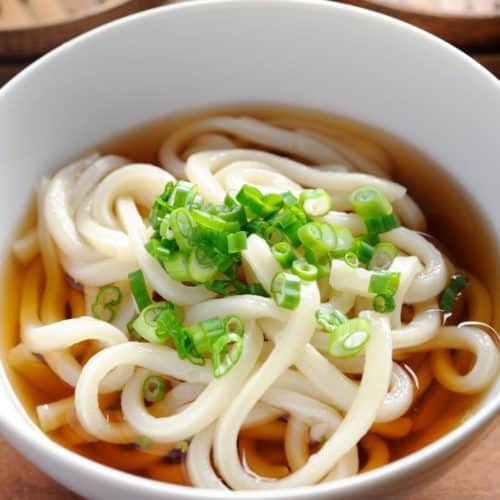Pork Belly Udon Soup
Pork belly just melts in your mouth, and the juices melt away in the dashi broth. Delicious!
Servings 4 people
Cost $8
Ingredients
Pork Belly
- 2 spring onions
- 7 oz pork belly
- 2 cloves garlic thinly sliced
- 1 thumb ginger grated
- ½ cup soy sauce
- ½ cup mirin
- ¼ cup sake
- 1 tbsp sugar
Dashi stock
- 3 inch kombu piece
- 4 cups water
- 3 cups katsuobushi bonito flakes
Udon Soup
- 1 packet udon noodles (7 oz.)
- 1 egg
- 2 tbsp soy sauce
- 2 tbsp mirin
- 2 tsp sugar
- 1¼ tsp salt
- 1 tbsp sake
- 1 bunch bok choy or pak choy (chopped into 2 inch pieces)
- ½ cup bean sprouts
- 1 sheet nori cut into 4 squares
- 2 spring onions
Instructions
- Chop off both of the ends of the spring onions (about 10cm in length), then cut them into an allumette, set them in a pan and add cold water to it. Reserve for later use (garnish).
- Chop what’s left of the spring onions into thin rounded slices.
- Put the saucepan on top of the stove, fill it with water and out the pork belly in. Turn on the heat and set to high, then bring to a boil. Simmer for 10 minutes.
- Remove the scum that floats on the water surface with a skimmer. Turn off the stove and remove the pork belly. Rinse with running water and then use paper towels to pat them dry.
- Replace the water in the saucepan with a clean one and boil the pork belly in it once more for another 30 minutes. Remove and rinse the pork once more and then pat dry with paper towels again as you did before. This time cut the pork belly into thick slices.
- Rinse the saucepan and make it ready for another round of cooking. Pour the sake, mirin and the soy sauce into the saucepan, then toss the spring onion, ginger and garlic as well.
- This time add the pork into the saucepan along with the other ingredients and simmer it until much of the liquid has evaporated leaving only a sticky sauce that makes the pork cuts look glossy. Turn off the stove and set the pork mix aside for later use.
- Now for making dashi stock. First, wipe down the kombu with a wet towel, then make a few slices along the length of the kombu at around 2 to 3 cm intervals).
- Get a new clean saucepan, pour water in it and place the kombu in the water, then bring to boil. After 2-3 minutes turn off the stove and remove the kombu and place it in a clean plate.
- Boil the bonito flakes in water too! Do this for about 30 seconds, turn off the stove and then wait for the bonito flakes to sink to the bottom of the pot (This should take about 10 minutes).
- Get a fine sieve strain (you may want to place paper towels over it to filter the liquid further) and pour the liquid from the bonito flakes that you’ve boiled earlier, then extract all the liquid.
- Boil the udon noodles for about 8-10 minutes until it becomes firm to the bite. Drain the hot water and rinse the noodles in cold running water.
- Divide the udon equally between 2 large serving bowls.
- Boil some water in a small pot. Use an egg piercer or a small pin to pierce the base of the egg and place it in the water. Stir regularly and cook for 6 and 1/2 minutes.
- Turn off the stove and remove the egg from the pot, then place it in a small bowl filled with cold water. Peel off the shell and then cut the egg in half, then set aside for later use.
- This time boil the Dashi stock in a large saucepan, reduce heat to simmer and add the mirin, soy sauce, sugar, sake, and salt.
- Stir the mix and sample the broth if it has the right taste (add a few more ingredients for seasoning if necessary). Simmer for a few more minutes in low heat.
- Next is to add the bok choy to the Dashi mix and simmer them for an additional 5 minutes.
- Pour the Dashi broth in each bowl of udon noodles. Decorate the udon with the sliced half boiled eggs, add some bean sprouts, spring onion allumette, and nori on the top, then serve.
